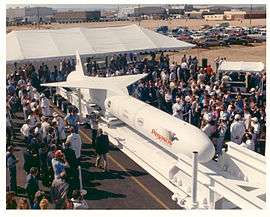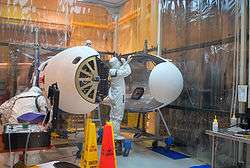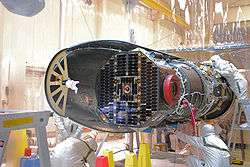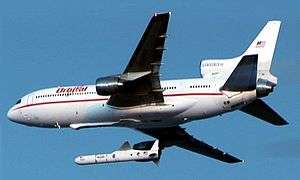Pegasus (rocket)
 | |
| Function | Launch vehicle |
|---|---|
| Manufacturer | Northrop Grumman |
| Country of origin | United States |
| Cost per launch | US$40 million |
| Size | |
| Height |
16.9 meters (55 ft) (Pegasus) 17.6 meters (58 ft) (Pegasus XL) |
| Diameter | 1.27 meters (4.2 ft) |
| Mass |
18,500 kilograms (40,800 lb) (Pegasus) 23,130 kilograms (50,990 lb) (Pegasus XL) |
| Stages | 3 |
| Capacity | |
| Payload to LEO |
443 kilograms (977 lb) (1.18 by 2.13 meters (3.9 ft × 7.0 ft)) |
| Associated rockets | |
| Family | Air launch to orbit |
| Derivatives | Minotaur-C |
| Launch history | |
| Status | Active |
| Launch sites | Air launch to orbit |
| Total launches | 43 |
| Successes | 38 |
| Failures | 3 |
| Partial failures | 2 |
| First flight | 5 April 1990 (Pegsat / NavySat) |
| Last flight | 15 December 2016 (CYGNSS) |
The Pegasus is an air-launched rocket developed by Orbital Sciences Corporation (now part of Northrop Grumman Innovation Systems after Northrop Grumman acquired Orbital ATK). Capable of carrying small payloads of up to 443 kilograms (977 lb) into low Earth orbit, Pegasus first flew in 1990 and remains active as of 2018. The vehicle consists of three solid propellant stages and an optional monopropellant fourth stage. Pegasus is released from its carrier aircraft at approximately 40,000 ft (12,000 m), and its first stage has a wing and a tail to provide lift and attitude control while in the atmosphere.[1]
Pegasus program
The Pegasus's three Orion solid motors were developed by Hercules Aerospace (now Alliant Techsystems) specifically for the Pegasus launcher. Additionally, wing and tail assemblies and a payload fairing were developed. Most of the Pegasus was designed by a team led by Antonio Elias.[2] The wing was designed by Burt Rutan.
- Mass: 18,500 kg (Pegasus), 23,130 kg (Pegasus XL)[1]:3
- Length: 16.9 m (Pegasus), 17.6 m (Pegasus XL)[1]:3
- Diameter: 1.27 m
- Wing span: 6.7 m
- Payload: 443 kg (1.18 m diameter, 2.13 m length)
Orbital's internal projects, the Orbcomm communications constellation and the OrbView observation satellites, plus Orbcomm-derived satellites (the "Microstar" platform) served as guaranteed customers and additional seed money. Soon after development began, several government and military orders were placed, as the Scout launcher was slated for phaseout.
The first successful Pegasus launch occurred on April 5, 1990 with NASA test pilot and former astronaut Gordon Fullerton in command of the carrier aircraft. Initially, a NASA-owned B-52 Stratofortress NB-008 served as the carrier aircraft. By 1994, Orbital had transitioned to their "Stargazer" L-1011, a converted airliner which was formerly owned by Air Canada. The name "Stargazer" is an homage to the television series Star Trek: The Next Generation: the character Jean-Luc Picard was captain of a ship named Stargazer prior to the events of the series, and his first officer William Riker once served aboard a ship named Pegasus.[3]
Initially, the Pegasus program had a high failure rate, about 40% until 1997. It lost six different cargoes, starting with 7 microsatellites on its second attempt, ending with the loss of gamma-burst identifying satellite HETE (High Energy Transient Explorer) in 1996.[4] Included was at least partial failure of three out of four Space Test Experiment Platform (STEP) efforts in the 1990s, on three separate launches.[5]


The Pegasus XL, introduced in 1994 has lengthened stages to increase payload performance. In the Pegasus XL, the first and second stages are lengthened into the Orion 50SXL and Orion 50XL, respectively. Higher stages are unchanged; flight operations are similar. The wing is strengthened slightly to handle the higher weight. The standard Pegasus has been discontinued; the Pegasus XL is still being produced. Pegasus has flown 43 missions in both configurations as of December 15, 2016.[6] Of these, 38 were considered successful launches.
Dual payloads can be launched, with a canister that encloses the lower spacecraft and mounts the upper spacecraft. The upper spacecraft deploys, the canister opens, then the lower spacecraft separates from the third-stage adapter. Since the fairing is unchanged for cost and aerodynamic reasons, each of the two payloads must be relatively compact.
For their work in developing the rocket, the Pegasus team led by Antonio Elias was awarded the 1991 National Medal of Technology by U.S. President George H. W. Bush.
The initial launch price offered was US$6 million, without options or a HAPS (Hydrazine Auxiliary Propulsion System) maneuvering stage. With the enlargement to Pegasus XL and the associated improvements to the vehicle, baseline prices increased. In addition, customers usually purchase additional services, such as extra testing, design and analysis, and launch-site support. As of 2015, the most recent Pegasus XL to be purchased—a planned June 2017 launch of NASA's Ionospheric Connection Explorer mission—had a total cost of $56.3 million, which NASA notes includes "firm-fixed launch service costs, spacecraft processing, payload integration, tracking, data and telemetry and other launch support requirements."[7]
For many small satellites it is desirable to be the primary payload and be placed into the orbit desired, as opposed to being a secondary payload placed in a compromise orbit. For example, Pegasus launches from equatorial launch sites can put spacecraft in orbits avoiding the South Atlantic Anomaly (a high radiation region over the South Atlantic Ocean) which is desirable for many scientific spacecraft. For some payloads, this may justify the higher cost of Pegasus relative to satellites launched as secondary cargoes on larger launchers.
Launch profile


In a Pegasus launch, the carrier aircraft takes off from a runway with support and checkout facilities. Such locations have included Kennedy Space Center / Cape Canaveral Air Force Station, Florida; Vandenberg Air Force Base and Dryden Flight Research Center, California; Wallops Flight Facility, Virginia; Kwajalein Range in the Pacific Ocean, and the Canary Islands in the Atlantic. Orbital offers launches from Alcantara, Brazil, but no known customers have performed any.
Upon reaching a predetermined staging time, location, and velocity vector the aircraft releases the Pegasus. After five seconds of free-fall, the first stage ignites and the vehicle pitches up. The 45-degree delta wing (of carbon composite construction and double-wedge airfoil) aids pitch-up and provides some lift. The tail fins provide steering for first-stage flight, as the Orion 50S motor does not have a thrust-vectoring nozzle.
Approximately 1 minute and 17 seconds later, the Orion 50S motor burns out. The vehicle is at over 200,000 feet (61 km) in altitude and hypersonic speed. The first stage falls away, taking the wing and tail surfaces, and the second stage ignites. The Orion 50 burns for approximately 1 minute and 18 seconds. Attitude control is by thrust vectoring the Orion 50 motor around two axes, pitch and yaw; roll control is provided by nitrogen thrusters on the third stage.
Midway through second-stage flight, the launcher has reached a near-vacuum altitude. The fairing splits and falls away, uncovering the payload and third stage. Upon burnout of the second-stage motor, the stack coasts until reaching a suitable point in its trajectory, depending on mission. Then the Orion 50 is discarded, and the third stage's Orion 38 motor ignites. It too has a thrust-vectoring nozzle, assisted by the nitrogen thrusters for roll. After approximately 64 seconds, the third stage burns out.
A fourth stage is sometimes added for a higher altitude, finer altitude accuracy, or more complex maneuvers. The HAPS (Hydrazine Auxiliary Propulsion System) is powered by three restartable, monopropellant hydrazine thrusters. As with dual launches, the HAPS cuts into the fixed volume available for payload. In at least one instance, the spacecraft was built around the HAPS.
Guidance is via a 32-bit computer and an IMU. A GPS receiver gives additional information. Due to the air launch and wing lift, the first-stage flight algorithm is custom-designed. The second- and third-stage trajectories are ballistic, and their guidance is derived from a Space Shuttle algorithm.
Carrier aircraft
The carrier aircraft (initially a NASA B-52, now an L-1011 owned by Orbital) serves as a booster to increase payloads at reduced cost. 40,000 feet (12,000 m) is only about 4% of a low earth orbital altitude, and the subsonic aircraft reaches only about 3% of orbital velocity, yet by delivering the launch vehicle to this speed and altitude, the reusable aircraft replaces a costly first-stage booster.
The single biggest cause of traditional launch delays is weather. Carriage to 40,000 feet takes the Pegasus above the troposphere, into the stratosphere. Conventional weather is limited to the troposphere, and crosswinds are much gentler at 40,000 feet. Thus the Pegasus is largely immune to weather-induced delays and their associated costs, once at altitude. (Bad weather is still a factor during takeoff, ascent, and the transit to the staging point).
Air launching reduces range costs. No blastproof pad, blockhouse, or associated equipment are needed. This permits takeoff from a wide variety of sites, generally limited by the support and preparation requirements of the payload. The travel range of the aircraft allows launches at the equator, which increases performance and is a requirement for some mission orbits. Launching over oceans also reduces insurance costs, which are often large for a vehicle filled with volatile fuel and oxidizer.
Launch at altitude allows a larger, more efficient, yet cheaper first-stage nozzle. Its expansion ratio can be designed for low ambient air pressures, without risking flow separation and flight instability during low-altitude flight. The extra diameter of the high-altitude nozzle would be difficult to gimbal. But with reduced crosswinds, the fins can provide sufficient first-stage steering. This allows a fixed nozzle, which saves cost and weight versus a hot joint.
A single-impulse launch results in an elliptical orbit, with a high apogee and low perigee. The use of three stages, plus the coast period between second- and third-stage firings, help to circularize the orbit, ensuring the perigee clears the Earth's atmosphere. If the Pegasus launch had begun at low altitude, the coast period or thrust profile of the stages would have to be modified to prevent skimming of the atmosphere after one pass.
For launches which do not originate from Vandenberg Air Force Base, the carrier aircraft is also used to ferry the assembled launch vehicle to the launch site. For such missions, the payload can either be installed at the base and ferried by the launch vehicle or be installed at the launch site.
In October 2016, Orbital ATK announced a partnership with Stratolaunch Systems to launch Pegasus-XL rockets from the giant Scaled Composites Stratolaunch, which could launch up to three Pegasus-XL rockets on a single flight.[8]
Related projects
Pegasus components have also been the basis of other OSC launchers. The ground-launched Taurus rocket places the Pegasus stages and a larger fairing atop a Castor 120 first stage, derived from the first stage of the MX Peacekeeper missile. Initial launches used refurbished MX first stages.
The Minotaur I, also ground-launched, is a combination of stages from Taurus launchers and Minuteman missiles, hence the name. The first two stages are from a Minuteman II; the upper stages are Orion 50XL and 38. Due to the use of surplus military rocket motors, it is only used for US Government and government-sponsored payloads.
A third vehicle is dubbed Minotaur IV despite containing no Minuteman stages. It consists of a refurbished MX with an Orion 38 added as a fourth stage.
The NASA X-43A hypersonic test vehicles were boosted by Pegasus first stages. The upper stages were replaced by exposed models of a scramjet-powered vehicle. The Orion stages boosted the X-43 to its ignition speed and altitude, and were discarded. After firing the scramjet and gathering flight data, the test vehicles also fell into the Pacific.
Launch statistics
Launch sites
- Edwards AFB
- Cape Canaveral
- Vandenberg
- Base Aerea de Gando
- Wallops Flight Facility
- Kwajalein Atoll
Launch outcomes
- Failure
- Partial failure
- Success
- Planned
Carrier airplane
- B-52
- L-1011
Launch history
Pegasus has flown 43 missions between 1990 and 2016.[6]
| Flight № | Date / time (UTC) | Rocket, Configuration |
Launch site | Payload | Payload mass | Orbit | Customer | Launch outcome |
|---|---|---|---|---|---|---|---|---|
| 1 | April 5, 1990 19:10:17 |
Standard (B-52) | Edwards AFB | Pegsat, NavySat | Success | |||
| 2 | July 17, 1991 17:33:53 |
Standard w/ HAPS (B-52) | Edwards AFB | Microsats (7 satellites) | Partial failure | |||
| Orbit too low, spacecraft reentered after 6 months instead of planned 3-years lifetime | ||||||||
| 3 | February 9, 1993 14:30:00 |
Standard (B-52) | Cape Canaveral | SCD-1 | Success | |||
| 4 | April 25, 1993 13:56:00 |
Standard (B-52) | Edwards AFB | ALEXIS – Array of Low Energy X-ray Imaging Sensors | Success | |||
| 5 | May 19, 1994 17:03:00 |
Standard w/ HAPS (B-52) | Edwards AFB | STEP-2 (Space Test Experiments Platform/Mission 2/SIDEX) | Partial failure | |||
| Orbit slightly low | ||||||||
| 6 | June 27, 1994 21:15:00 |
XL (L-1011) | Vandenberg AFB | STEP-1 (Space Test Experiments Platform/Mission 1) | Failure | |||
| Loss of vehicle control 35s into flight, flight terminated | ||||||||
| 7 | August 3, 1994 14:38:00 |
Standard (B-52) | Edwards AFB | APEX | Success | |||
| 8 | April 3, 1995 13:48:00 |
Hybrid (L-1011) | Vandenberg AFB | Orbcomm (2 satellites), OrbView-1 | Success | |||
| 9 | June 22, 1995 19:58:00 |
XL (L-1011) | Vandenberg AFB | STEP-3 (Space Test Experiments Platform/Mission 3) | Failure | |||
| Destroyed during second-stage flight | ||||||||
| 10 | March 9, 1996 01:53:00 |
XL (L-1011) | Vandenberg AFB | REX II | Success | |||
| 11 | May 17, 1996 02:44:00 |
Hybrid (L-1011) | Vandenberg AFB | MSTI-3 | Success | |||
| 12 | July 2, 1996 07:48:00 |
XL (L-1011) | Vandenberg AFB | TOMS – Total Ozone Mapping Spectrometer | Success | |||
| 13 | August 21, 1996 09:47:00 |
XL (L-1011) | Vandenberg AFB | FAST (Fast Auroral Snapshot Explorer) | Success | |||
| 14 | November 4, 1996 17:08:00 |
XL (L-1011) | Wallops Flight Facility | HETE, SAC-B | Failure | |||
| Satellites not ejected from third stage | ||||||||
| 15 | April 21, 1997 11:59:00 |
XL (L-1011) | Base Aerea de Gando, Gran Canaria, Spain | MiniSat, Celestis space burial | Success | |||
| 16 | August 1, 1997 20:20:00 |
XL (L-1011) | Vandenberg AFB | OrbView-2 | Success | |||
| On the line with partial success | ||||||||
| 17 | August 29, 1997 15:02:00 |
XL (L-1011) | Vandenberg AFB | FORTE | Success | |||
| 18 | October 22, 1997 13:13:00 |
XL (L-1011) | Wallops Flight Facility | STEP-4 (Space Test Experiments Platform/Mission 4) | Success | |||
| 19 | December 23, 1997 19:11:00 |
XL w/ HAPS (L-1011) | Wallops Flight Facility | Orbcomm (8 satellites) | Success | |||
| 20 | February 26, 1998 07:07:00 |
XL (L-1011) | Vandenberg AFB | SNOE, BATSAT | Success | |||
| 21 | April 2, 1998 02:42:00 |
XL (L-1011) | Vandenberg AFB | TRACE | Success | |||
| 22 | August 2, 1998 16:24:00 |
XL w/ HAPS (L-1011) | Wallops Flight Facility | Orbcomm (8 satellites) | Success | |||
| 23 | September 23, 1998 05:06:00 |
XL w/ HAPS (L-1011) | Wallops Flight Facility | Orbcomm (8 satellites) | Success | |||
| 24 | October 22, 1998 00:02:00 |
Hybrid (L-1011) | Cape Canaveral | SCD-2 | Success | |||
| 25 | December 6, 1998 00:57:00 |
XL (L-1011) | Vandenberg AFB | SWAS | Success | |||
| 26 | March 5, 1999 02:56:00 |
XL (L-1011) | Vandenberg AFB | WIRE – Wide Field Infrared Explorer | Success | |||
| 27 | May 18, 1999 05:09:00 |
XL w/ HAPS (L-1011) | Vandenberg AFB | Terriers, MUBLCOM | Success | |||
| 28 | December 4, 1999 18:53:00 |
XL w/ HAPS (L-1011) | Wallops Flight Facility | Orbcomm (7 satellites) | Success | |||
| 29 | June 7, 2000 13:19:00 |
XL (L-1011) | Vandenberg AFB | TSX-5 (Tri-Services Experiments Platform/Mission 5) | Success | |||
| 30 | October 9, 2000 05:38:00 |
Hybrid (L-1011) | Kwajalein Atoll | HETE 2 | Success | |||
| 31 | February 5, 2002 20:58:00 |
XL (L-1011) | Cape Canaveral | RHESSI | Success | |||
| 32 | January 25, 2003 20:13:00 |
XL (L-1011) | Cape Canaveral | SORCE | Success | |||
| 33 | April 28, 2003 12:00:00 |
XL (L-1011) | Cape Canaveral | GALEX – Galaxy Evolution Explorer | Success | |||
| 34 | June 26, 2003 18:55:00 |
XL (L-1011) | Vandenberg AFB | OrbView-3 | Success | |||
| 35 | August 13, 2003 02:09:00 |
XL (L-1011) | Vandenberg AFB | SCISAT-1 | Success | |||
| 36 | April 15, 2005 17:27:00 |
XL (L-1011) | Vandenberg AFB | DART | Success | |||
| 37 | March 28, 2006 20:10:00 |
XL (L-1011) | Vandenberg AFB | ST-5 – Space Technology 5 (3 satellites) | Success | |||
| 38 | April 25, 2007 20:26:00 |
XL (L-1011) | Vandenberg AFB | AIM – Aeronomy of Ice in the Mesosphere | Success | |||
| 39 | April 15, 2008 17:01:00 |
XL (L-1011) | Kwajalein Atoll | C/NOFS | Success | |||
| 40 | October 19, 2008 17:47:23 |
XL (L-1011) | Kwajalein Atoll | IBEX – Interstellar Boundary Explorer | Success | |||
| 41 | June 13, 2012 16:00:00 |
XL (L-1011) | Kwajalein Atoll | NuSTAR – Nuclear Spectroscopic Telescope Array | Success [9] | |||
| 42 | June 28, 2013 02:27:46 [10] |
XL (L-1011) | Vandenberg AFB | IRIS – Interface Region Imaging Spectrograph SMEX | Success [11] | |||
| 43 | December 15, 2016 13:37:00 |
XL (L-1011) | Cape Canaveral | Cyclone Global Navigation Satellite System (CYGNSS) [12] | Success[13] | |||
Planned launches
| Date / time (UTC) | Rocket, Configuration |
Launch site | Payload | Orbit | Customer |
|---|---|---|---|---|---|
| October 26, 2018[14] | XL (L-1011) | Cape Canaveral | Ionospheric Connection Explorer (ICON) [15] | ||
| 44; Delayed from original Dec 3 2017 date | |||||
Launch failures
- Flight F-2, July 17, 1991: A faulty pyrotechnic system caused the rocket to veer off course during 1st-stage separation, resulting erratic maneuvers that prevented the rocket reaching the correct orbit, and the payload reentered the atmosphere 6 months after launch, although planned for a 3-year lifetime[16]
- Flight F-5, May 19, 1994: A software navigation error caused the HAPS upper stage to shut down early, resulting in a lower than planned orbit. The Pegasus carried the DoD Space Test Program's satellite - Space Test Experiments Platform, Mission 2 (STEP-2).
- Flight F-6, June 27, 1994: The vehicle lost control 35 seconds into flight, telemetry downlink lost 38 seconds into flight, range safety commanded flight termination 39 seconds into flight. The likely reason for loss of control was improper aerodynamic modelling. The Pegasus carried the DoD Space Test Program's satellite - Space Test Experiments Platform, Mission 1 (STEP-1).
- Flight F-9, June 22, 1995: The interstage ring between the 1st and 2nd stages did not separate, constraining movement of the 2nd-stage nozzle. As a result, the rocket deviated from its intended trjectory and was ultimately destroyed by range safety. The Pegasus carried the DoD Space Test Program's satellite - Space Test Experiments Platform, Mission 3 (STEP-3).
- Flight F-14, November 4, 1996: Failed to separate payloads because of a discharged battery intended to start separation pyros. Battery damage during launch was the likely reason.
- Flight F-16, August 1, 1997: The rocket reached orbit 98 km below planned for unknown reasons, likely an extreme case of solid rocket performance variation. The satellite reached the correct orbit using its own thrusters.
See also
References
- 1 2 3 "Pegasus User's Guide" (PDF). orbitalatk.com. October 2015. Archived from the original (PDF) on 13 January 2016.
- ↑ Brown, Stuart (May 1989), "Winging it Into Space", Popular Science, Bonnier Corporation, p. 128, ISSN 0161-7370, retrieved 27 June 2013
- ↑ "startrek.com". startrek.com.
- ↑ Pegasus clings to its satellite cargo
ASTRONOMERS hoping to a solve a riddle that has dogged them for two decades had their hopes dashed last week, when a rocket launching a pair of astrophysical satellites into orbit hung onto the spacecraft instead...The problem came after the third stage of the Pegasus rocket, which is launched from beneath an aircraft, reached the planned orbit. The explosive device which should have released the satellites failed to ignite, sending the rocket and satellites tumbling in an orbit that is expected to decay within months, leaving the spacecraft to burn up in the atmosphere. - ↑ NASA reviews space access after second Pegasus failure
- 1 2 "Pegasus Mission History". Orbital Science Corporation.
- ↑ "NASA Awards Launch Services Contract for Ionospheric Connection Explorer". NASA.
- ↑ Foust, Jeff (October 6, 2016). "Stratolaunch to launch Pegasus rockets". SpaceNews. Retrieved June 7, 2018.
- ↑ "NuSTA" (PDF). December 2010. Archived from the original (PDF) on 2011-07-17.
- ↑ "NASA's Consolidated Launch Schedule". NASA. 2013-05-14.
- ↑ "IRIS Launch Coverage". NASA. June 27, 2013.
- ↑ "NASA Awards Launch for Orbital's Pegasus Rocket". Orbital press release. April 1, 2014.
- ↑ Graham, William (15 December 2016). "Pegasus launches CYGNSS constellation following Stargazer release". NASASpaceFlight. Retrieved 16 December 2016.
- ↑ Pietrobon, Steven (September 22, 2018). "United States Commercial ELV Launch Manifest". Retrieved September 23, 2018.
- ↑ "ICON Mission Overview". NASA. June 18, 2017.
- ↑ International reference guide to space launch systems, Fourth edition, page 290, ISBN 1-56347-591-X
External links
| Wikimedia Commons has media related to: |
- ↑ Plain, Charlie (October 18, 2004). "Special Delivery: The Pegasus XL Rocket". NASA. Retrieved August 8, 2012.